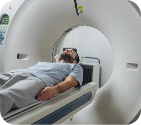
The kidneys are located on each side of the spine just above the waist. They make urine by filtering waste products and extra water from the blood. They also help regulate blood pressure.
Kidney cancer is an abnormal growth of cells in one or both kidneys. Renal cell cancer (or renal cell carcinoma) is the most common type of kidney cancer.
The cause of this disease is not known. It occurs mostly in adults who are over 40 years old. The risk for kidney cancer is higher if you:
 Are male
Are male
 Are obese
Are obese
 Smoke tobacco
Smoke tobacco
 Have high blood pressure
Have high blood pressure
 Are being treated with long-term dialysis
Are being treated with long-term dialysis
 Have von Hippel-Lindau syndrome (a hereditary disease)
Have von Hippel-Lindau syndrome (a hereditary disease)
Symptoms can include:
A lump that can be felt in the abdomen
Pain in the lower side of the back or the side (called flank pain) that does not go away
Diagnosis
With the advent of more people undergoing ultrasounds and scans, incidental “lumps” in the kidney are sometimes noted that give rise to concern.A CT scan of the kidney is required to better characterize the lump and see if it is likely to be cancerous.
In some cases, removal and examination of the lump (excision or partial nephrectomy) is necessary to provide a conclusive answer.

CT Scan
CT Scan
An abdominal CT scan involves taking X-ray images of the abdomen from many angles. The X-ray beams are detected by the scanner and analyzed by a computer. The computer reconstructs the data into a picture of the body area being scanned. These images can be viewed on a monitor or reproduced as films.
The CT scanner is a free-standing machine with a large hole in the center. The patient lies on a narrow table that slides into the hole. Patients who have difficulty with enclosed spaces such as those found with some MRI scanners do not usually have a problem here.The actual scan time is usually about two minutes, although the entire procedure usually takes much longer.
A dye may be injected into a vein to better evaluate certain diseases and organs. When doing a quick screening for stones, dye injection is usually not necessary. A CT Scan offers several advantages over the IVP:
It is able to show the "meat" of the kidneys, where the kidney cancers and lumps are often situated. This is not seen in the IVP which only shows the inner outline of the urinary tract. This is why, if a lump is suspected on the IVP, fine CT sectioning of the kidney is performed to grade the likelihood of a lump being cancerous.
If a patient's symptoms are not very specific, CT allows a general "screening" of other abdominal organs in addition to the urinary tract.
See more
Treatment for Kidney Cancer
The treatment for kidney cancer depends on how large the tumor is, whether the tumor has spread to other parts of the body, and your general health.
Usually the kidney is removed with surgery (nephrectomy). The chances of cure depend on how large the tumor is and whether it has spread to other parts of the body.
If the cancer has not spread to nearby lymph nodes or other tissues, the long-term survival rates after surgical removal of the kidney are good. After treatment your doctor will recommend regular checkups to follow your recovery and to check for signs whether the cancer has come back or spread. These checkups may include blood tests, X-rays, and scans. It is important to follow your doctor’s recommendations for checkups so that any problems can be found early.
Biotherapy, also called immunotherapy, which helps the body’s own defenses to fight the cancer is used when the cancer has spread outside the kidney.
Prevention

Limit or prevent, if possible, your exposure to cigarette smoke, which is associated with increased risk for this disease. Have regular checkups to monitor your blood pressure and health.